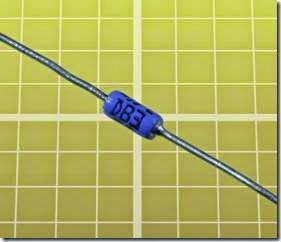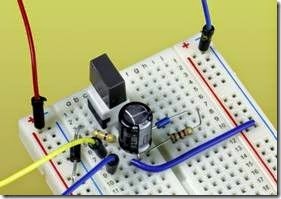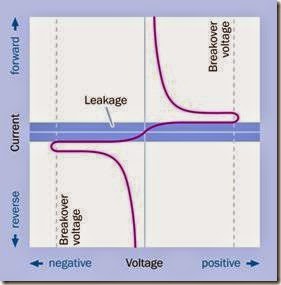diac
A diac is a self-triggering type of thyristor. Its name is said to be derived from the phrase “diode for AC,” and because it is not an acronym, it is not usually capitalized.
A thyristor is defined here as a semiconductor having four or more layers of p-type and n-type silicon. Because the thyristor predated integrated circuits, and in its basic form consists of a single multilayer semiconductor, it is categorized as a discrete component in this encyclopedia. When a thyristor is combined with other components in one pack- age (as in a solid-state relay) it is considered to be an integrated circuit.
Other types of thyristor are the SCR (silicon-controlled rectifier) and the triac, each of which has its own entry in this encyclopedia.
Thyristor variants that are not so widely used, such as the gate turn-off thyristor (GTO) and
silicon-controlled switch (SCS), do not have entries here.
The diac is a bidirectional thyristor with only two terminals. It blocks current until it is subjected to sufficient voltage, at which point its impedance drops very rapidly. It is primarily used to trigger a triac for purposes of moderating AC power to an incandescent lamp, a resistive heating element, or an AC motor. The two leads on a diac have identical function and are interchangeable.
By comparison, a triac and an SCR are thyristors with three leads, one of them being referred to as the gate, which determines whether the com- ponent becomes conductive. A triac and a diac allow current to flow in either direction, while an SCR always blocks current in one direction.
Symbol Variants
The schematic symbol for a diac, shown in Figure 2-1, resembles two diodes joined togeth- er, one of them inverted relative to the other. Functionally, the diac is comparable with a pair of Zener diodes, as it is intended to be driven be- yond the point where it becomes saturated. Be- cause its two leads are functionally identical, they do not require names to differentiate them. They are sometimes referred to as A1 and A2, in rec- ognition that either of them may function as an anode; or they may be identified as MT1 and MT2, MT being an acronym for “main terminal.”
Figure 2-1. Symbol variants to represent a diac. All four are functionally identical.
The symbol may be reflected left to right, and the black triangles may have open centers. All of these variants mean the same thing. Occasion- ally the symbol has a circle around it, but this style is now rare.
When only a moderate voltage is applied (usually less than 30V) the diac remains in a passive state and will block current in either direction, al- though a very small amount of leakage typically occurs. When the voltage exceeds a threshold known as its breakover level, current can flow, and the diac will continue to conduct until the current falls below its holding level.
A sample diac is shown in Figure 2-2.
Figure 2-2. Because a diac is not intended to pass significant current, it is typically packaged in a small format. The graph squares in the photograph each measure 0.1”.
How It Works
Figure 2-3 shows a circuit that demonstrates the conductive behavior of a diac.
Figure 2-3. A test circuit to demonstrate the behavior of a diac. See text for details.
When the pushbutton is held down, current from the positive side of the AC supply flows through the diode and the 470K resistor to the capacitor. The diac is not yet conductive, so the capacitor accumulates a potential that can be monitored with the volt meter. After about 30 seconds, the charge on the capacitor reaches 32V. This is the breakover voltage for this particular diac, so it becomes conductive. The positive side of the capacitor can now discharge through the diac and the 1K series resistor to ground.
If the pushbutton is released at this moment, the meter will show that the capacitor discharges to a potential below the holding level of the diac. The capacitor now stops discharging because the diac has ceased being conductive.
If the pushbutton is held down constantly, the meter will show the capacitor charging and then discharging through the diac repeatedly, so that the circuit behaves as a relaxation oscillator. The 1K series resistor is included to protect the diac from excessive current. If a standard quarter-watt resistor is used, it should not become unduly warm because current passes through it only intermittently.
• Because this circuit uses 115VAC, basic pre- cautions should be taken. The fuse should not be omitted, the capacitor should be rat- ed for at least 50V, and the circuit should not be touched while it is connected to the pow- er source. Breadboarding a circuit using this voltage requires caution and experience, as wires can easily come loose, and compo- nents can be touched accidentally while they are live.
Figure 2-4 shows the test circuit on a breadboard. The red and blue leads at the top of the photo- graph are from a fused 115VAC power supply. The live side of the supply passes through a diode to a pushbutton switch that has a rectangular black cap. A 470K resistor connects the other side of the switch to the positive side of a 100µF elec- trolytic capacitor, and also to the diac (small blue component). A 1K resistor connects the other end of the diac back to the negative side of the capacitor, which is grounded. The yellow and blue wires leaving the photograph at the left are connected with a volt meter, which is not shown.
Figure 2-4. A breadboarded version of the diac test cir- cuit. See text for details.
The behavior of a diac is also illustrated in Figure 2-5, which can be compared with the curves in Figures 3-10 and 1-8, depicting the behavior of a triac and an SCR respectively.
Figure 2-5. The curve shows current passing through a diac when various voltages are applied.
Switching AC
The diac cannot function as a switch, because it lacks the third terminal which is found in a triac, an SCR, or a bipolar transistor. However, it is well suited to drive the gate of a triac, because the behavior of a diac is symmetrical in response to opposite voltages, while the triac is not. If an AC voltage applied to a diac is adjusted with a po- tentiometer in an RC circuit, the diac will pass along a portion of each positive or negative pulse, and will delay it by a brief amount of time determined by the value of the capacitor in the RC circuit and the setting of the potentiometer. This is known as phase control, as it controls the phase angle at which the diac allows current to flow.
See Figure 3-13 for a schematic showing a diac driving a triac. See Figures 1-14 and 3-11 for graphs illustrating phase control. See “Phase Control” for a discussion of phase in AC wave- forms.
Variants
Diacs are available in through-hole and surface- mount formats. Because they are not intended to handle significant current, no heat sink is included.
A sidac behaves very similarly to a diac, its name being derived from “silicon diode for alternating current.” Its primary difference from generic di- acs is that it is designed to reach its breakover voltage at a higher value, typically 120VAC or 240VAC.
Values
When performing its function to trigger a triac, a diac is unlikely to pass more than 100mA.
The breakover voltage of a diac is usually be- tween 30V and 40V, with a few versions designed for up to 70V. When the diac starts to conduct, its on-state impedance is sufficient to reduce the voltage significantly, with 5V being a typical min- imum output voltage.
Although the rise time when a diac responds is very brief (around 1µs), the component is not ex- pected to run at a high frequency. It will normally be used with 50Hz or 60Hz AC to trigger a triac. For this reason, its repetitive peak on-state cur- rent is usually specified at no more than 120Hz.
Abbreviations in datasheets are likely to include:
• VBO Breakover voltage (sometimes may be specified as latching voltage, which for a diac is the same thing).
• VBO1 – VBO2 Breakover voltage symmetry. The hyphen is intended as a minus sign, so that this value is the maximum difference be- tween breakover voltage in each direction.
• VO Minimum output voltage.
• ITRM Repetitive peak on-state current.
• IBO Breakover current, usually the maximum required, and less than 20µA.
• IR Maximum leakage current, usually less than 20µA.
• TJ Operating junction temperature, usually expressed as an acceptable range.
What Can Go Wrong
Like other semiconductors, a diac is heat sensi- tive. Usual precautions should be taken to allow sufficient ventilation and heat sinking, especially when components are moved from an open pro- totyping board to an enclosure in which crowd- ing is likely.
Unexpected Triggering Caused by Heat
On a datasheet, a value for breakover current is valid only within a recommended temperature range. A buildup of heat can provoke unexpec- ted triggering.
Low-Temperature Effects
A higher breakover voltage will be required by a diac operating at low temperatures, although the variation is unlikely to be greater than plus- or-minus 2% within a normal operating range. Temperature has a much more significant effect on a triac.
Manufacturing Tolerances
The breakover voltage for a diac is not adjustable, and may vary significantly between samples of the component that are supposed to be identical. The diac is not intended to be used as a precision component. In addition, while its break- over voltage should be the same in either direction, a difference of plus-or-minus 2% is possible (1% in some components).





